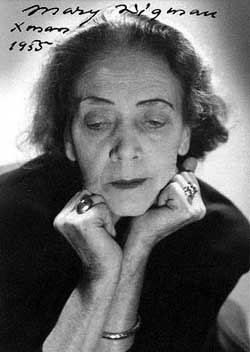 Mary Wigman lived from 1886 to 1973, and was the
leading force of the German Modern Dance Movement for over 50 years. Wigman first studied
under Delcroze, and then with Rudolf van Laban when she was almost 24 years old. Mary became Laban’s assistant in
developing his dance notation system. In 1920, her school in Dresden first opened. Eventually the school grew and developed branches all over Germany, including one in New York headed by her
student, Hanya HolmWigman taught her technique, which was
based on structured improvisations in her school. She also excelled at solo
choreography. Her two most famous works,
“Witch Dance” and “Monotony Whirl” were both created in 1926. Mary Wigman considered herself an expressionist, and was heavily influenced by expressionist
painter Emil Nolde. Wigman believed that Art grows out of the basic cause of existence. She is responsible for the development of the
Absolute Dance form. Her German Heritage, training, and personality
influenced her work as well as the atmosphere of Pre-Nazi Germany. After World War II, Wigman
re-established her school in West Berlin and continued teaching until she
retired in the late 1960s. With the rise of Tanztheater, a style associated
with Pina Bausch, Mary Wigman’s work was revived in the 1970s.
Mary Wigman lived from 1886 to 1973, and was the
leading force of the German Modern Dance Movement for over 50 years. Wigman first studied
under Delcroze, and then with Rudolf van Laban when she was almost 24 years old. Mary became Laban’s assistant in
developing his dance notation system. In 1920, her school in Dresden first opened. Eventually the school grew and developed branches all over Germany, including one in New York headed by her
student, Hanya HolmWigman taught her technique, which was
based on structured improvisations in her school. She also excelled at solo
choreography. Her two most famous works,
“Witch Dance” and “Monotony Whirl” were both created in 1926. Mary Wigman considered herself an expressionist, and was heavily influenced by expressionist
painter Emil Nolde. Wigman believed that Art grows out of the basic cause of existence. She is responsible for the development of the
Absolute Dance form. Her German Heritage, training, and personality
influenced her work as well as the atmosphere of Pre-Nazi Germany. After World War II, Wigman
re-established her school in West Berlin and continued teaching until she
retired in the late 1960s. With the rise of Tanztheater, a style associated
with Pina Bausch, Mary Wigman’s work was revived in the 1970s.Sunday, February 16, 2014
Biography of Mary Wigman
 Mary Wigman lived from 1886 to 1973, and was the
leading force of the German Modern Dance Movement for over 50 years. Wigman first studied
under Delcroze, and then with Rudolf van Laban when she was almost 24 years old. Mary became Laban’s assistant in
developing his dance notation system. In 1920, her school in Dresden first opened. Eventually the school grew and developed branches all over Germany, including one in New York headed by her
student, Hanya HolmWigman taught her technique, which was
based on structured improvisations in her school. She also excelled at solo
choreography. Her two most famous works,
“Witch Dance” and “Monotony Whirl” were both created in 1926. Mary Wigman considered herself an expressionist, and was heavily influenced by expressionist
painter Emil Nolde. Wigman believed that Art grows out of the basic cause of existence. She is responsible for the development of the
Absolute Dance form. Her German Heritage, training, and personality
influenced her work as well as the atmosphere of Pre-Nazi Germany. After World War II, Wigman
re-established her school in West Berlin and continued teaching until she
retired in the late 1960s. With the rise of Tanztheater, a style associated
with Pina Bausch, Mary Wigman’s work was revived in the 1970s.
Mary Wigman lived from 1886 to 1973, and was the
leading force of the German Modern Dance Movement for over 50 years. Wigman first studied
under Delcroze, and then with Rudolf van Laban when she was almost 24 years old. Mary became Laban’s assistant in
developing his dance notation system. In 1920, her school in Dresden first opened. Eventually the school grew and developed branches all over Germany, including one in New York headed by her
student, Hanya HolmWigman taught her technique, which was
based on structured improvisations in her school. She also excelled at solo
choreography. Her two most famous works,
“Witch Dance” and “Monotony Whirl” were both created in 1926. Mary Wigman considered herself an expressionist, and was heavily influenced by expressionist
painter Emil Nolde. Wigman believed that Art grows out of the basic cause of existence. She is responsible for the development of the
Absolute Dance form. Her German Heritage, training, and personality
influenced her work as well as the atmosphere of Pre-Nazi Germany. After World War II, Wigman
re-established her school in West Berlin and continued teaching until she
retired in the late 1960s. With the rise of Tanztheater, a style associated
with Pina Bausch, Mary Wigman’s work was revived in the 1970s.
Subscribe to:
Post Comments (Atom)
This comment has been removed by the author.
ReplyDelete